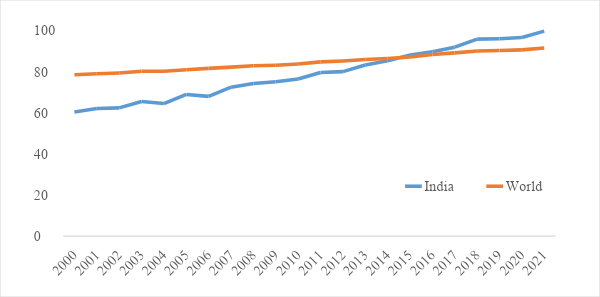.png)
Electrification has been a major development goal for independent India. At the dawn of independence, power availability was limited to a few cities, with rural areas having absolutely no access to electricity. India now boasts of 100 percent household electrification. Figure 1 shows India’s significant progress in the last decade when the pace of electrification in India overtook the world average. However, the country is still far away from the 2022 goal of ensuring 24x7 electricity access. While there is no standard definition for access to electricity, the common understanding of electricity access is about a household having an electricity connection to the grid or having a standalone system for electricity supply. This basic access is sufficient to light four to six bulbs, charge a mobile, and operate a fan and a television. The consumption level of electricity varies across places and economic classes and has the potential to increase or decrease within the household or institution over a period. The disruptions in power supply due to faults, inadequate generation, or any other reasons are termed power cuts or power outages.
Figure 1: Percentage of population with access to electricity (India and the World)

Source: The World Bank
Electricity is now an integral part of daily living, such as providing light after sunset, operating appliances, taking up livelihood activities, making digital transactions, providing access to decent healthcare facilities, providing education through smart classes, and so on. In today’s world, electricity unlike water, is not necessary for human survival but is a necessity for a good human life. As per the Rural Health Statistics, about 11.4 percent of India’s sub-centres (part of rural health infrastructure in India) and 3.7 percent of primary health centres were without electric supply in March 2022. Reliable power is necessary for operating medical equipment to ensure safe childbirth in health centers and storing immunisation vaccines. Access to electricity has clear positive impacts on household incomes and livelihoods. Research suggests that electricity access boosts the incomes of household businesses by an average of about 35 percent. Moreover, most youngsters need to access learning portals and jobs portals for education and job searches. Thus, electricity is more than a connection, it’s a path to the basic rights and essentials of life.
Electricity is now an integral part of daily living, such as providing light after sunset, operating appliances, taking up livelihood activities, making digital transactions, providing access to decent healthcare facilities, providing education through smart classes, and so on.
Lars Löfquist, an expert on humanitarian ethics, energy, and development, argues that the “right to electricity is often necessary to protect our basic rights like the right to life and other material needs like adequate housing, healthcare, and education. Still, it is life, housing, healthcare, and education that are essential, not electricity.” In India, electricity is not considered an essential commodity within the provisions of the Essential Commodities Act of 1955, even though petroleum and petroleum products are included in the essential commodities list.
The Ministry of Power in India promulgated the Electricity (Rights of Consumers) Rules 2020 in December 2020 under section 176 of the Electricity Act 2003. The rule mentioned that it is the right of consumers to have minimum standards of service for the supply of electricity from the distribution licensee. The distribution licensee shall supply 24x7 power to all consumers as per the standards of performance. Amendments were made to the Electricity (Rights of Consumers) Rule in the years 2021, 2022, and 2023. Public notices informing the consumers that 24x7 power supply is the right of consumers was published. The consumers have the right to claim compensation if a distribution company resorts to willful load shedding. For example, during the middle of the year 2023, the West Bengal State Electricity Distribution Company Limited (WBSEDCL) published a public notice on the Electricity (Rights of Consumers) Rules—2020 (Indian Express Kolkata Edition, 28 June 2023). These steps make electricity a contractual right of the connection holder.
The rule mentioned that it is the right of consumers to have minimum standards of service for the supply of electricity from the distribution licensee.
The Electricity Act 2003 balances the financial health of the Licensees (Distribution Companies) and Consumer Protection. Section 56 of The Electricity Act 2003 mentions disconnection in case of any neglect to pay any charge for electricity or any sum other than a charge for electricity after a prescribed notice period, while Section 57 of the Act is about Consumer Protection. On the ground, there are disconnection cases due to overdue payments. In one of the court cases in the Punjab High Court during 2022, the judgment quoted “It cannot be over-emphasized that electricity being a basic necessity, is an integral part of the right to life as enshrined under Article 21 of the Constitution of India. Therefore, as long as the petitioner has the suit property, he cannot be deprived of electricity.”
In case of disconnection due to payment overdue, especially in the case of economically poor households, there are possibilities of changes in the actual percentage of electricity access. The change in proportion might create or keep a gap from the target of exact 100 percent access. The importance of electricity is growing daily in society, be it in education, communication, healthcare, transportation (with electric vehicles gaining momentum), or banking. Access to electricity is more than a connection. Considering the growing importance of electricity in accessing other necessities, more prominent and strong measures must be considered to ensure a continued basic electricity supply.
In case of disconnection due to payment overdue, especially in the case of economically poor households, there are possibilities of changes in the actual percentage of electricity access.
One measure is to replace the complete disconnections with the continued supply of only the prescribed basic units of electricity, especially in the case of economically poor consumers. Such measures can justify 100 percent household electrification. The per capita bar for energy access is 50-100 kWh as per the International Energy Agency (IEA). The states may decide the basic electricity units to be supplied to households in the face of payment overdue.
Another measure is to provide a power backup system independent of the grid supply. The recently announced Pradhanmantri Suryodaya Yojana provides rooftop solar for 1 crore poor and middle-class households. The households are expected to receive about 300 units of solar electricity with an option to sell surplus electricity to distribution companies. Sometimes power cuts occur for days in remote locations due to technical faults and nature-driven reasons. The recent Suryodaya scheme now shapes solar rooftop systems as a system for power backup, a system to reduce electricity bills, and a system for the continued supply of electricity. In a nutshell, society’s dependence on electricity is increasing rapidly, therefore, it is time to consider electricity as an essential commodity and make it a right rather than a goal, privilege, or contractual right.
Manjushree Banerjee works as an independent consultant on Energy Access.
The views expressed above belong to the author(s). ORF research and analyses now available on Telegram! Click here to access our curated content — blogs, longforms and interviews.



.png)
 PREV
PREV

.png)
.png)